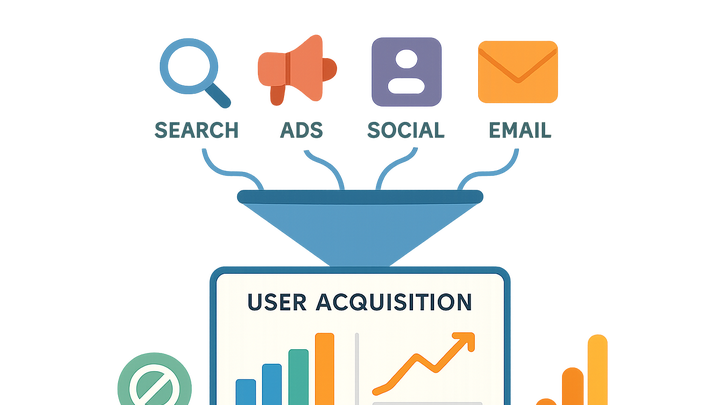Published on 2025-06-28T04:26:13Z
What Is User Acquisition in Analytics? Examples with PlainSignal & GA4
User Acquisition is the process of attracting new visitors and converting them into users for your website or mobile app. In the analytics context, it involves tracking and measuring the effectiveness of various marketing channels and campaigns to see how they drive fresh traffic and sign-ups. Tools like PlainSignal—a cookie-free, privacy-friendly analytics solution—and Google Analytics 4 (GA4) allow you to monitor acquisition channels, calculate costs, and optimize growth strategies. PlainSignal uses a lightweight JavaScript snippet to capture visits and referral data without relying on cookies, while GA4 employs an event-driven model to collect user data across web and app properties. Understanding user acquisition helps marketing and product teams allocate budgets, improve conversion rates, and drive sustainable growth.
User acquisition
Methods and metrics for tracking how new users discover and engage with your website or app.
Definition of User Acquisition
User Acquisition refers to the process of attracting and converting new users to your digital property. It encompasses strategies for reaching potential users, understanding their journey, and encouraging them to take meaningful actions such as signing up, subscribing, or making a purchase. Analytics platforms attribute these conversions to specific channels and campaigns, enabling teams to compare performance and ROI. A clear definition helps unify marketing and analytics efforts around shared goals and metrics.
-
Acquisition channels
- Organic Search
- Paid Search
- Social Media
- Referral
- Direct Traffic
- Email Marketing
-
Organic search
Users arriving via search engines like Google without paid ads.
-
Paid search
Traffic from search engine advertising campaigns such as Google Ads.
-
Social media
Visits generated from social platforms like Facebook, Twitter, and LinkedIn.
-
Referral
Clicks coming from external websites, blogs, or partner sites.
-
Direct traffic
Users who type your URL directly or access your site via a bookmark.
-
Email marketing
Visits originating from links in email newsletters or campaigns.
Why User Acquisition Matters
Effective user acquisition drives the growth and sustainability of digital products. By understanding which channels deliver the best ROI, teams can allocate budgets more strategically. Strong acquisition tactics reduce wasted spend and ensure a steady influx of new users. This becomes especially critical in competitive markets or for startups aiming to scale quickly.
-
Growth and scalability
New users fuel revenue growth and allow you to scale your product through increased engagement and word-of-mouth.
-
Cost efficiency
Measuring acquisition costs reveals which channels deliver the highest value, helping optimize your marketing budget.
Key Metrics in User Acquisition
Monitoring the right KPIs ensures you have a clear view of acquisition effectiveness. These metrics help evaluate the performance of campaigns and channels over time.
-
Cost per acquisition (cpa)
Average cost to acquire a new user. Calculated by dividing total marketing spend by the number of new users.
-
Formula
CPA = Total Marketing Spend / Number of New Users
-
-
Conversion rate
Percentage of visitors who perform a desired action such as sign-up or purchase.
-
Formula
Conversion Rate = (Number of Conversions / Total Visitors) × 100
-
-
Customer lifetime value (clv)
Projected revenue from a user over the duration of their relationship with your product.
-
Importance
CLV informs how much you can invest in acquiring customers profitably.
-
Tracking User Acquisition with PlainSignal and GA4
Implement analytics solutions to capture acquisition data transparently. PlainSignal offers a cookie-free model, while GA4 provides deep, cross-platform insights using an event-based structure.
-
Tracking with PlainSignal
Insert this snippet before the closing <head> tag to enable PlainSignal tracking:
<link rel="preconnect" href="//eu.plainsignal.com/" crossorigin /><script defer data-do="yourwebsitedomain.com" data-id="0GQV1xmtzQQ" data-api="//eu.plainsignal.com" src="//cdn.plainsignal.com/plainsignal-min.js"></script>PlainSignal will then automatically record visits and acquisition channels without using cookies.
-
Tracking in GA4
Use the global site tag to set up GA4 tracking:
<script async src="https://www.googletagmanager.com/gtag/js?id=G-XXXXXXXXXX"></script> <script> window.dataLayer = window.dataLayer || []; function gtag(){dataLayer.push(arguments);} gtag('js', new Date()); gtag('config', 'G-XXXXXXXXXX'); </script>Then access Reports > Acquisition > User acquisition in the GA4 interface to analyze source and medium performance.
Best Practices for User Acquisition
Apply these guidelines to enhance acquisition performance and maintain compliance:
-
Implement utm parameters
Use UTM tags on campaign URLs to ensure accurate attribution of traffic sources in analytics platforms.
-
A/b test campaigns
Experiment with different creatives, messages, and landing pages to discover top-converting variations.
-
Prioritize privacy and compliance
Ensure tracking respects GDPR, CCPA, and other data protection regulations, especially when using third-party tools.
-
Analyze and iterate
Regularly review acquisition reports, shift budgets to high-performing channels, and refine targeting criteria.
